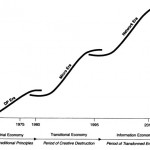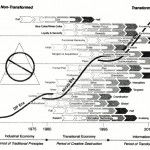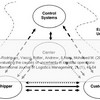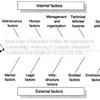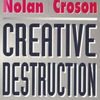 Like with so many of my other recent book reviews I came across Nolan and Croson’s book, Creative Destruction: A Six-Stage Process for Transforming the Organization when researching my book chapter on risks in Virtual Enterprise Networks. This book triggered my interest when I became aware of the concept of “creative destruction”, where some businesses must die for others to be (re-)born. Popularized by Joseph Schumpeter, “creative destruction” is a concept that makes perfect sense to me.
Like with so many of my other recent book reviews I came across Nolan and Croson’s book, Creative Destruction: A Six-Stage Process for Transforming the Organization when researching my book chapter on risks in Virtual Enterprise Networks. This book triggered my interest when I became aware of the concept of “creative destruction”, where some businesses must die for others to be (re-)born. Popularized by Joseph Schumpeter, “creative destruction” is a concept that makes perfect sense to me.
Joseph Schumpeter
I had never heard about Joseph Schumpeter before, and I don’t even remember where I came across the term “creative destruction”, so I searched Wikipedia, next to Google, my nuber 1 source of information:
The Austrian economist Joseph Schumpeter used the term to describe the process of transformation that accompanies radical innovation. In Schumpeter’s vision of capitalism, innovative entry by entrepreneurs was the force that sustained long-term economic growth, even as it destroyed the value of established companies that enjoyed some degree of monopoly power.
So, what Schumpeter is saying, is that large corporations eventually become rigid and antiquated and then replaces by faster-moving, responsive and innovative competitors, and one of the ways an economy moves forward is by destroying the old in order to create new opportunities.
The role of IT
One of messages from the book is that the last thing a company should think about is how to to stand the test of time, because once they are successful, companies tend to institutionalize the thinking that allowed them to thrive, and this, in turn, becomes their doom. If you stop innovating, if you do not destroy or transform, you die. And at the heart of the transformation or destruction lies ICT, Information and Communication Technology. Bearing in mind that the book was written in 1995, while I am writing this in 2009, ICT had not even really begun to transform the business world into what we see today, and it that sense the book is a bit outdated as to foreseeing what ICT can do, but essentially the authors are getting it right.
Hail IT and globalization, here we come…
As I said, the book was written in 1995 and is a bit of the typical late 1990’s “Hail IT” and “Hail Globalization” books. I will not argue that IT will keep transforming the way we do business, but globalization? Yes, some, or actually, much good has come from it, but in the current financial downturn, we also see the potentially disastrous effects of the global cobweb of interlinked business, where one falling pawn tears down the next one and so on. Or, is this just another form of creative destruction? Speaking of which, after reading the book, it doesn’t talk much about innovating, it talks more about making money. And it’s not so much about destruction, it’s about transformation.
The transformation stages
There are a couple of interesting illustrations in the book, referring to how ICT in the business world has transformed the management the organization and the workforce of businesses from the data processing era of the 1960’s, via the microcomputers era of the 1980’s, to the proposed network era of the 21st century, where companies need to transform the traditional hierarchical pyramid-shaped organization structure into a network of self-designed teams.
(Illustrations are taken from the book)
The six stages of creative destruction
The books describes six stages of “creative destruction”:
- Downsize
- Forcefully (and painfully) downsizing at a grand scale (30-50%) reinforces transformation
- Seek Dynamic Balance
- Develop a sound balance between stakeholders’ ROI and internal wages and bonuses
- Develop a Market Access Strategy
- Focus on delivering quality rather than quantity
- Become Customer Driven
- “Make and Sell” becomes “Sense and Respond”
- Develop a Market Foreclosure Strategy
- Products have life cycles, they cannot go on forever
- Pursue Global Scope
- As some markets close, new markets must open
On the outside, the only “destruction” I see is the downsizing and life-cycle perspective. But that is before I take into account the destruction of the traditional hierarchy and the establishing of functional networks. That is truly a destruction and an innovative transformation re-birth.
Has it begun?
Interestingly, they predict that it will take some 50 years to complete this throughout the business world. Whether it will really happen remains to be seen, but the advent of business networks as in The Networked Enterprise foretells what is to come, and my guess is that it will take far less than 50 years.
Reference
Nolan, R. L., & Croson, D. C. (1995). Creative Destruction: A Six-Stage Process for Transforming the Organization. Boston, MA: Harvard Business School Publishing.
Author link
- hbs.edu: Richard L Nolan
- cox.smu.edu: David C Croson
amazon.com
Related
- husdal.com: Book Review: How Nature works
- husdal.com: A new perspective: The Supply Chain Life Cycle

